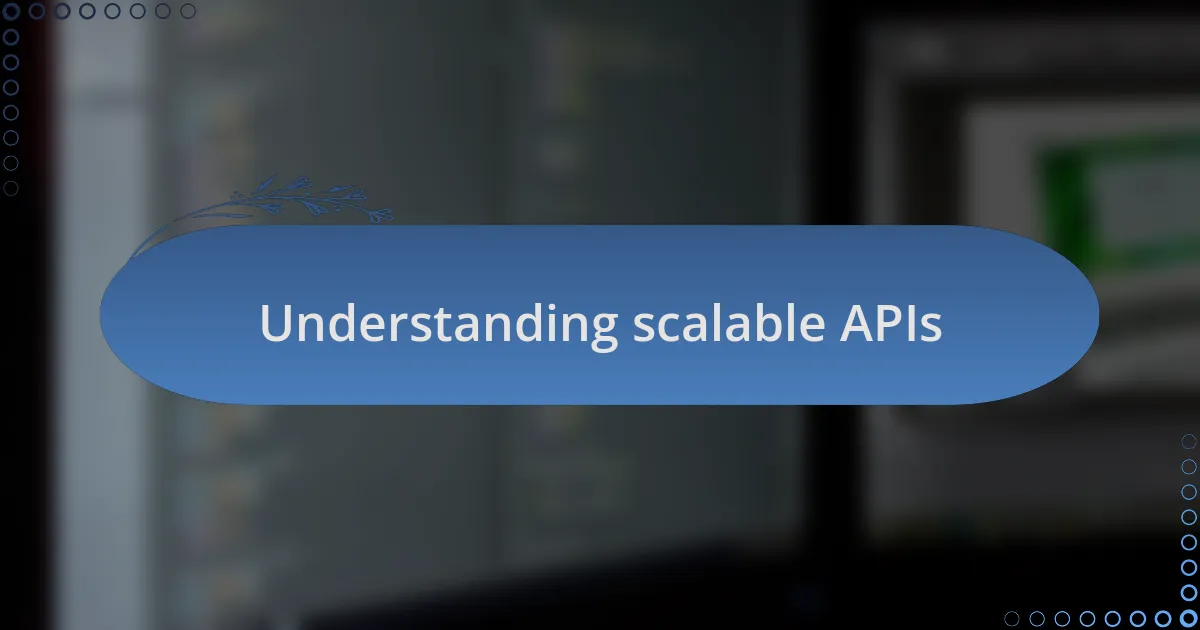Key takeaways:
- Scalability requires a mindset focused on flexibility and efficiency, as well as performance optimization through strategies like caching.
- Adopting modular architectures, such as microservices, allows independent scaling of components and reduces the impact of system-wide changes.
- Continuous monitoring and improvement of APIs, informed by user feedback, is essential for maintaining performance and anticipating future needs.
- Clear documentation and effective versioning strategies are critical for smooth development, minimizing confusion, and ensuring stability during updates.

Understanding scalable APIs
When I first delved into building scalable APIs, I realized that scalability isn’t just a feature; it’s a mindset. I remember the challenges we faced while trying to accommodate an unexpected jump in traffic. That initial panic made me realize how critical it is to design APIs with flexibility and efficiency in mind from the outset.
I often reflect on a moment when our team implemented caching strategies to alleviate server load. It was empowering to witness how a simple adjustment could enhance response times dramatically. Have you ever experienced transforming a sluggish response into a lightning-fast interaction? Such moments underscore the importance of performance optimization in making an API scalable.
Beyond just the technical aspects, understanding user needs is crucial for scalability. I’ve learned that designing APIs with adaptability means anticipating future requirements, which can often feel overwhelming. But in my experience, engaging with users to gather feedback has often guided us toward creating more robust solutions. How do you envision your API evolving in the future? For me, it’s about striking that delicate balance between current capabilities and future potential.

Key principles of API scalability
One of the key principles of API scalability is adopting a modular architecture. I remember when we shifted to microservices, it felt like we were freeing our development team from the shackles of monolithic structures. This approach allowed us to scale individual components independently, which transformed the way we handled updates. Have you ever felt the burden of making a change that impacts the entire system? With microservices, that pressure dissipated, making our development process much more effective.
Load balancing is another critical aspect that I learned through trial and error. Initially, our team struggled under the weight of spikes in user demand, but implementing a load balancer proved to be a game-changer. It not only distributed incoming traffic evenly but also enhanced redundancy, which gave us a sense of security. Can you recall a time when unforeseen demand put your system at risk? Learning to distribute that load evenly has been a valuable lesson in maintaining both reliability and performance.
Finally, continuous monitoring and improvement are essential for a scalable API. In my experience, we can’t just set it and forget it; we need to be vigilant. I remember how our analytics tools revealed hidden bottlenecks that we hadn’t anticipated, pushing us to refine our methods. How often do you revisit your API’s performance? Embracing a mindset of ongoing assessment has been crucial for ensuring that our API not only meets current demands but is poised for future growth.

Lessons learned from building APIs
Building APIs taught me the importance of clear documentation. Early on, I underestimated how essential it was to have well-defined endpoints and usage examples. I still recall a late-night debugging session where confusion over an undocumented parameter led to hours of fixating on what should have been a simple request. Have you ever faced a similar situation? Clear documentation can save time and reduce frustration, ultimately leading to a smoother development experience.
Another lesson I learned is the significance of effective versioning strategies. At first, we treated our APIs like they were set in stone, which caused anxiety during updates. Reflecting on those times, I remember the relief that came with adopting a robust versioning system. It allowed us to roll out new features without breaking existing functionality. Have you considered how versioning impacts your API’s longevity? Proper version control provides confidence to both developers and users, ensuring that changes can be made without sacrificing stability.
Lastly, user feedback is an invaluable resource that should never be overlooked. Initially, I neglected to gather insights from those actually using the API. There was a moment when a developer reached out to us with suggestions that reshaped our endpoint design. Their firsthand experience highlighted pain points we had completely missed. When was the last time you reached out for user input? Real-world feedback makes your API not just scalable but also more aligned with the actual needs of its users.